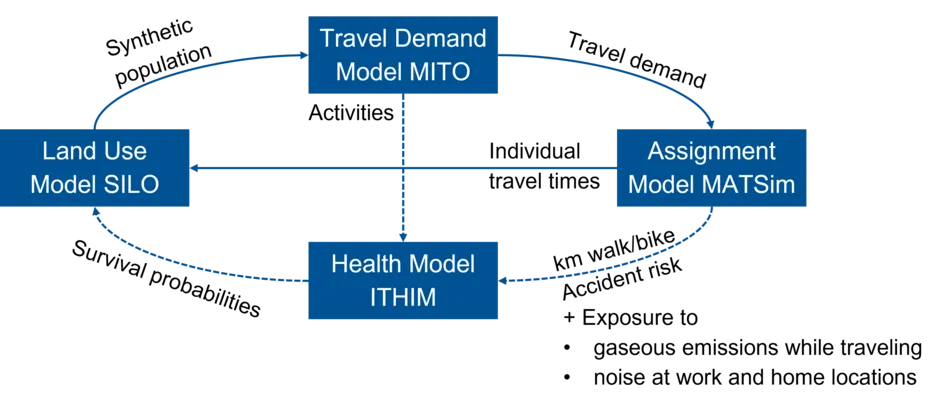GLASST
Global and Local health Assessment of Transport

The GLASST is a five-year project led by Dr James Woodcock from University of Cambridge and conducted in cooperation between multiple collaborators (more details). The main task of this project is to develop the next generation of transport and health impact models and tools that are academically robust and practically useful to predict how changes in travel patterns and related exposures (e.g. physical activity, air pollution, and road traffic danger) might influence health outcomes (e.g. injuries, heart disease, some cancers and diabetes). The task for TUM Chair of Travel Behavior is to integrating the transport modeling suite (SILO/MITO/MATSim) with the health model ITHIM.
Subtask 1: Simulating health behaviors in travel demand models
MITO is a state-of-the-art agent-based travel demand model. We extends MITO to microscopically simulate individuals’ travel behavior as relevant to their health. First, we developed new approaches to model demand over a full 7-day period, a time frame more representative of people’s habitual behavior and more consistent with the time frames used in the public health field. Second, we extended modelled trip purposes by developing new statistical models to understand the determinants of RRTs and simulate these trips in our demand model. Finally, we developed an individual level ‘mode set’ model which predicts the modes an individual is willing to consider for their trips. Including this in the simulation enables to capture habitual mode choice behavior during a full week.
Subtask 2: Microscopically capturing health exposures
MATSim is an state-of-the-art agent-based network assignment tool, and we use it to assign travel demand (modelled in MITO) to the network. In this project, we extends MATSim to capture individual-level health exposures (physical activity, air pollution, accidents) based on their behavior. Micro-exposures are calculated as agents travel along each link on the network, and then these are aggregated to up the individual.
Subtask 3: Bringing life tables into agent-based land use modeling
SILO is a state-of-the art land use model which simulates long-term population and land use changes, including births and deaths. We extends SILO to make use of life tables for simulating mortality rates and life expectancy. In the simulation, mortality rates are updated dynamically for each agent using modelled health outcomes based on the exposures captured in MATSim.
Subtask 4: Implementing SILO to the Greater Manchester area
In this project, we implements SILO to the Greater Manchester area for microscopically simulating demographic events (e.g. birth, deaths, marriage/divorce and leave parental home) and land use changes (e.g. household relocation and new house construction). In the SILO Manchester model, the synthetic population is generated using Iterative Proportional Updating (IPU) algorithm based on the UK census data and the English housing survey data. Model parameters are mostly obtained from the Munich implementation and then calibrated to match the UK census data and population projection data. The house rent price is one of the key inputs for the land use model. However, rent price is usually poorly recorded in the survey data. In this study, we developed a linear regression model for predicting rent prices of the synthetic dwellings by using the data recorded on the rightmove website.
| Keywords | Land Use and Transport Modeling, Health Assessment Tool |
| Auftrag- / Fördergeber | European Research Council (ERC) under the European Union’s Horizon 2020 research and innovation programme (grant agreement No 817754) |
| Weitere Projektbeteiligte | MRC Epidemiology Unit, University of Cambridge (Dr James Woodcock) |
| Laufzeit | 2019- 2024 |
| Ansprechpartner | Qin Zhang, Rolf Moeckel, Corin Staves |